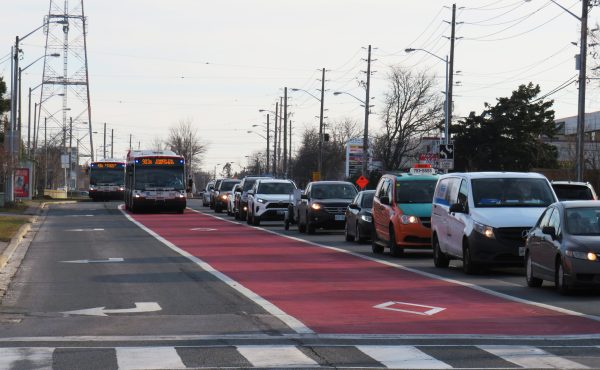
 It was nice to read a sports column today in the Star that wasn’t exactly about sports. Cathal Kelly, the Star’s man at the World Cup in Germany, has a great piece about the country’s train system and the social life that encompasses the area surrounding each city’s central train station.
It was nice to read a sports column today in the Star that wasn’t exactly about sports. Cathal Kelly, the Star’s man at the World Cup in Germany, has a great piece about the country’s train system and the social life that encompasses the area surrounding each city’s central train station.
For once, the cliché rings true — the trains do run on time in Germany. Die Bahn’s vast, interconnected rail network is the lifeline of this World Cup, transporting supporters to and from each of the 12 host cities. And except when you’re surprised half-naked by its representatives, it’s a marvellous enterprise.The ICE — inter-city express — trains shrink the 600-km journey from Munich in the south to Berlin in the north to six hours, by travelling at speeds approaching 300 km/h in spots. The hauptbahnhof (main station) in each town also serves as the hub of activity, where people eat, drink, sing, drink, blow their horns and generally annoy the passing throng of Germans who’d rather be home watching the game than going to work.
The above photo is in Cologne outside the city’s hauptbahnhof. Also, Mark Sim, one of Spacing‘s new reporters who starts work in September, is following his beloved South Korean team around Germany and sent along a few photos of street celebrations, as well as a unique parking garage in Frankfurt that maximizes the limited amount of space available.






8 comments
How does the train going 300kph take 6 hours to do the 600k between Berlin and Munich? Long stops? Sounds like VIA.
I thought the same thing too, but just passed over it as a possible typo.
Ha… you two have done to many math problems featuring trains leaving stations…
How does the train going 300kph take 6 hours to do the 600k between Berlin and Munich? Long stops? Sounds like VIA.
The article stated – approaching 300 km/h in spots so it’s not a sustained 300.
And the stops aren’t long – they have power cars on both ends so the train is quick pulling out of the station in whichever direction. The longest stop for ICE trains tends to be under 10 minutes (generally at terminus-style stations – Munich, Frankfurt, Leipzig, Stuttgart) – with a 2 minute stop normal even in large cities.
Having ridden more than my fair share of the German “Beautiful Weekend Ticket” – all the local trains nationwide for either a Saturday or Sunday for up to 5 adults for only 30 euros – I believe I’ve seen more than my fair share of German trackage.
It’s fairly hilly country when the train follows a (fairly) straight line south from Berlin to Munich (esp. between Leipzig & Nuremburg). They use tilting technology ICE trains on exisiting trackage – hence the lower speed limits. If they use the ICE favourably-designed lines (i.e. the Stendal line via Wolfsberg/Braunschweig and the Goettingen-Fulda line) and loop around to Munich it takes only about a 1/2 hr more – the 300+ km/h speed is sustained for longer periods of time.
I think it’s more like 700 km.
Anyway, DB is like the anti-VIA. Does VIA allow you to transfer from mainline trains to city subways, trams and buses free of charge? No. Does VIA have bicycle stands in intercity express trains that travel 250km/h? No. Does VIA have bike rental services at every station in a town greater than 10,000 people? No. Hell, VIA doesn’t even service the city of Calgary, Alberta (pop. 1,000,000) and of the 400 places that it does serve, it’s infrequent and usually late. Geoffrey Simpson of the Globe and Mail used to poke fun of VIA rail’s punctuality saying that if you need to bring a book to kill time before waiting for a friend to arrive, you’d better bring “War and Peace”.
By the numbers, VIA rail transports about 4 million people a year and DB schlepps 2 billion Germans a year.
leonard to be fair (only a little bit) to VIA:
1) It receives a miniscule amount of money in comparison to DB – from both the feds and the provinces. Germany dumped billions and billions upgrading their high-speed lines through the 80s and 90s (and fixing all the former East German infrastructure).
2) Passenger trains take priority over freight on the DB. Since VIA has to ‘rent’ lines from the mainline railways it’s the other way around here.
3) Do you even think that Moscoe would do something that progressive to integrate with the TTC?
North America never really upgraded its train experience (outside of Acela). There was an article in la Presse about 9 years ago (I cut it out – that’s why I remember) showing that the train service between New York City and Chicago actually now takes longer than it did 60 years ago.
Via to me almost seems like 2 different train systems. I look at Atlantic Canada or the trans-Canadian, and they are mainly tourist routes where they discuss the “experience.” There are infrequent departures and lots of overnight trains.
From Quebec City to Windsor, and specifcally from Toronto to Montreal they are a high speed carrier. Lots of depatures with an empahsis on the business traveller – WIFI et al.
I wonder if we might not be better off if we split the company in two – allow the “tourist” side to market their trans-Canadian adventures, and get a high speed carrier side to provide service in the Quebec Windsor corridor.
And while VIA is no European carrier, it does run one of the fastest trains in all of North America. The Express run from Toronto to Montreal in 3 hours and 44 minutes, averaging 142 km/h. The Acela, while having a top speed of 240 km/h only averages 143 km/h from Washington to New York.
Geoff and Greg:
Well, yeah, VIA can always say that it’s not Amtrak.
Even before we contemplate spending money on infrastructure upgrades, little things could go long ways to improving the service on board. Right now, when you buy a ticket to travel on VIA, you have to stand in a line and go to an assigned car depending on what station you’re at. Then, you’re not free to move around the train and there’s always one conductor on each car. By contrast, a 14-car train in Europe might have as few as three staff on board: the driver and two conductors. What I’ve found on VIA is that these sorts of practices simply increase overhead costs which, in turn, must be paid for out of higher ticket prices. It cost me $20 to take VIA from Oshawa to Toronto once (60km). By contrast, it cost EUR2.75 to take the train from Padova to Venice (30 km). Something is wrong here.